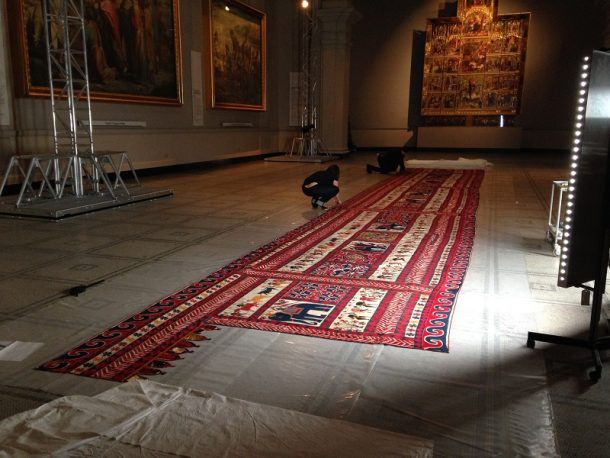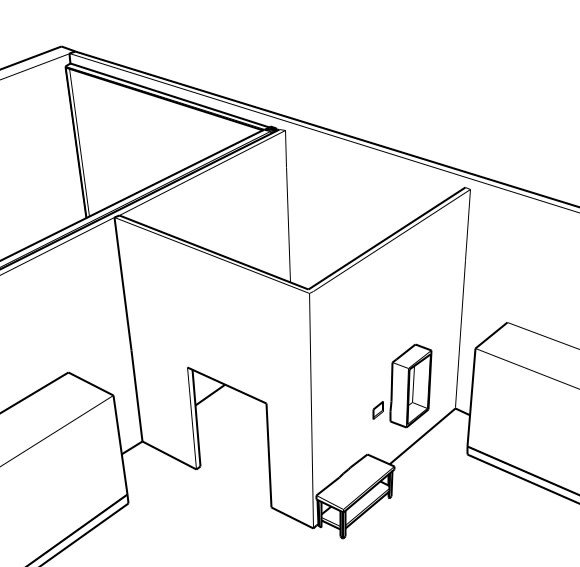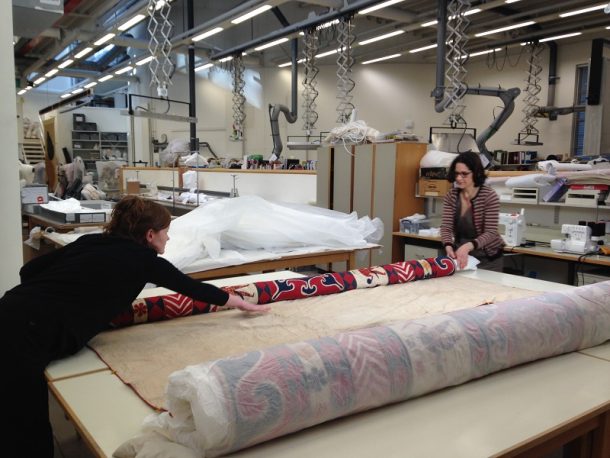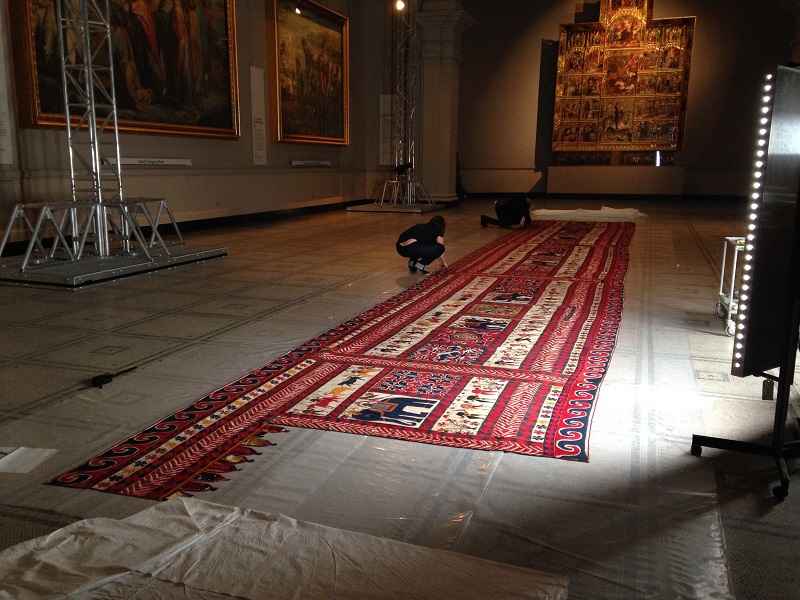
Back in February, after months (really years) of preparation, the V&A formally announced The Fabric of India to the press. Rosemary and Divia spoke with a number of journalists about all the spectacular objects that will be in the show – from Tipu Sultan’s 18th century tent to Manish Arora’s latest designs. But one piece in particular got maybe a little more than its share of the limelight, due to its mysterious back-story (we all know how journalists love a good story). If you caught any of this coverage, you may be thinking you know what to expect from this incredible textile – but you’d be wrong.
In fact, after months of rolling out, measuring, conserving, planning and re-planning, even our team was blown away by this Saurashtran ceremonial room hanging when we recently mounted it as a room for the very first time. Since we needed images of the mounted work for the book, we thought we could use the opportunity to run-through the practicalities of putting this massive (huge!) object up for display in the exhibition. And as with all aspects of this exhibition, this was an undertaking made possible only through the combined expertise of many extremely talented and skilled people. The result you can see in the film below, which gives a taster (3 out of 4 walls worth) of what it will be like for you as a visitor to walk into this captivating room.
But first, to provide a little perspective on this object and its challenges, we’ve gathered together a few members of our team to discuss how and why we want to give visitors the experience of being surrounded by this object – despite the formidable logistics. (Not the least of which has been how on earth to fit an object of this size into an exhibition already packed to the rafters spectacular things…).
First, Rosemary tells us the fascinating story of its discovery and journey to the V&A, and why, as a curator, she wanted it included in the show:
“This amazing, huge hanging was found abandoned along with some beer crates on the street in Brooklyn, New York, by Mr Jerome Burns. Checking that it really was being thrown out and nobody wanted it, he hurried back to his office (he worked as an art appraiser), found someone with transport, and collected it from the sidewalk. He then realised he had nowhere big enough to display or even store the piece. Yearly visitors to the UK, Mr and Mrs Burns visited the V&A in 1994, and asked us if we would like to have the piece as a donation, paying only the cost of getting it to London from New York. We accepted this extremely kind offer, as we had nothing of this kind in the collection. Until now, however, we have not had the space even to put up the hanging, still less display it, so The Fabric of India will be the first time it will be able to be seen by the public. This recent opportunity to test-mount the piece allowed us to see how it will look in the exhibition, as well as enabling our photographers to get excellent images of it for the book The Fabric of India.”

Next, Gitta Gschwendtner, our exhibition designer, discusses how we determined the shape of the room, and what that means for the visitor:
“The wedding room hanging provided a number of challenges for the design of its display. The exact way in which it would have been used is unknown so assumptions had to be made as to what kind of a room-shape it could form. The repeated chevron pattern was judged to be a corner design, which led to the room shape that we have come up with. The visitor will be able to see, though, that the sides do not quite add up to form a complete rectangle. Once the size and shape of the room had been decided we needed to make a judgement on how to protect the hanging from being touched while still allowing enough space for the visitor to enter the room and fully experience being inside this magnificent environment. The final decision was to have a 1 metre distance created by barriers on the two sides and back, while the entrance of the room is protected with acrylic sheeting. The design of the display has been a close collaboration between the conservators, museum security and curators facilitating this great exhibit to be shown for the first time.”
Next, Olivia Oldroyd, our exhibitions manager, talks further about this collaboration, and balancing the needs of the museum with those of the desired visitor experience:
“During early design conversations the curators communicated that it was important to give the visitor the experience of walking into a real, decorated room. In order to realise this, we set about taking some measurements so that Gitta was able start designing the structure (this was done earlier in the year in the Raphael Court, where we managed to roll out the full 17 meters of the room).
Whilst it is important that the structure is a room, we also have to ensure it is both safe for the object and the visitor. We started our conversations with Health and Safety, Security and the Estates department to ensure the proposed structure of the room works with the existing fabric of the building, and that access and circulation meet the requirements of the museum. At the same time, we have been meeting with Conservation and Technical Services to discuss how the object can be mounted and displayed safely inside its structure.
We will shortly be appointing the build contractors who will use a draftsman to turn Gitta’s final design of the room mount into a construction drawing ready for build. The next step for me is to turn the decisions and discussion of the past few months into a schedule that will be used for the installation of the wedding room.”

Finally, Elizabeth-Anne, one of our team of conservators, tells us about the process of getting an object of this scale up (it takes more than just muscles…):
“Ever since Rosemary said that she really wanted the wedding room photographed in an ‘architectural setting’ for the publication, the hunt has been on to find a suitable space in the museum large enough to hang the 2.5 metre high by 16.6 metre wide textile! In the exhibition the textile will hang from Velcro; the soft loop Velcro side is stitched to the top edge of the object and will be attached to corresponding hook Velcro fixed to the room’s walls. However, this bespoke gallery space will not be ready until the September installation so for the purposes of the publication a temporary room had to be constructed. The Photo Studio turned out to be almost the perfect size with just enough space to hang the textile and for the photographers to position their cameras far enough back to capture three sides of the room.
In the time lapse video you can watch the temporary room structure being built. Large textiles are regularly hung in the Photo Studio so we were able to utilise the existing Velcro batten at the far end of the room, which has a mechanised hoist to adjust the height. Once the batten was set to the correct height for the textile, Technical Services built scaffold towers at either side to support temporary Velcro battens for the side walls, these battens were secured to the underside of the balcony at the other end of the studio from which the time lapse photography was filmed.
Textiles are often rolled up to reduce their size, which makes them easier to handle. Normally a textile can be rolled horizontally, from the bottom of the textile up to the Velcro edge at the top, so the Velcro can then be attached to the batten and the textile carefully unrolled when ready for display. However, because of its exceptionally long length, the wedding textile had to be Velcro-ed from the roller to its battens with the roller held vertically. To help the roller stay upright it was slotted onto a support with a slippy base so that it could be spun around as we walked it round the room. It was very helpful to have a ‘trial run’ of hanging this exceptional textile, as we now have a much better idea of how the textile will look on display and how we will install it in the exhibition space.
If you look carefully during the video you can see me and my colleague placing little pieces of coloured fabric into gaps in the applique decoration. These were just temporary repairs for photography but look out for a future post on the actual conservation treatment.”
And here is the video itself:
If you enjoyed this behind-the-scenes-peek, look out for follow-up future posts with more delightful details about preparing this amazing object for its big debut.
Thanks to our Photography studio for allowing us to take over their space; Technical Services, for building us a space; and Peter Kelleher for filming the space!

I am so enjoying all of the posts about this exhibit – I cannot wait to see it all in person.
Can’t wait to see it. Child of twice migrated parents from saurashtra.
I would be delighted to receive any posts relating to this Fabric of India exhibition. As well, I might have a piece from Swat in Pakistan that would be of some interest to you. If so, please let me know as I would happily contribute it for your exhibition.
SHW
Thanks for Sharing Information Very Helpful Post….